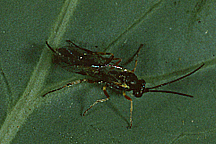Common name: Diadegma wasp, Diadegma
Scientific name:
Diadegma semiclausum, D.insulare, D. mollipla,
D. fenestral
Hymenoptera:Ichneumonidae
Type
Larva parasitioids
Hosts
Cabbage diamondback moth, potato tuber moth, cabbage webworm
Description
The egg is found inside the body of the host larva - where the larva is then hatched.
It eats the contents of the host larva. After the host larva spins its cocoon, the Diadegma larva eventually kills it and spins its own cocoon inside that of
the host. The Diadegma kills its host only at the stage when the host larva stops feeding and starts to pupate.
The pupa is the black colored developing wasp which can be seen inside the cocoon, in place of the light colored diamondback moth pupa.
The adult Diadegma wasps are very small about 6 mm to 1 cm long. They are found in cruciferous crops and herbaceous plants. Their population is dependent on the population of their hosts. They are the most important natural enemies of DBM and can parasitize up to 90% of their larvae. They can parasitize both exposed and hidden larvae as some species have short ovipositors while others have long ones that can reach hidden larvae. The total development period from egg to adult is about 2-3 weeks under temperate conditions (Philippine German Plant Protection Project, 1996: pp. 1-17).
Conservation and management
To conserve Diadegma populations, plants with nectar sources are recommended, such as members of the cabbage
family, which have wide or shallow corollas. They can feed on nectars of corn, beans, alfalfa, tomatoes, apples, and flowering weeds where hosts are also found.
Adult female wasps feed on nectar and pollen as well as on honeydew of aphids (Kfir, 1997).
Diadegma wasps are highly susceptible to pesticides. They are killed through direct contact, wherein the larvae inside the hosts die when their hosts are killed by pesticides. Heavy infestations of diamondback moth are more prevalent in the fields that are sprayed heavily. It is advised to avoid discriminate use of pesticide (Philippine German Plant Protection Project, 1996: pp. 1-17).
The following practices are suggested when introducing Diadegma in the field:
- Make sure that the field environment is pesticide-free.
- Release Diadegma wasps at their adult stage at a ratio of 200 females to 100 males or an optimal sex ratio of 2 females to 1 male. The
presence of too many males disturbs the females, which in turn affects their reproductive behavior.
- 300 per release is the recommended number to avoid an overcrowded population. The female has the tendency to lay unfertilized eggs or more male offspring once there is an overpopulation.
- Releases should be done at weekly intervals for at least 5 times, good enough for the insects to be well-established.
- The temperature should be low enough; about 18-25 degrees C, and field location should be 600 m or more above sea level, to allow them to reproduce successfully.
- Monitor insect parasitism regularly. Black cocoons mean a parasitized DBM larva or Diadegma wasp is developing inside the cocoon (Philippine German Plant Protection Project, 1996: pp. 1-17).
The introduction of Diadegma wasps into the field is to reduce the DBM population to a level below the economic threshold and to establish Diadegma as an integral part of the local insect fauna.
It takes about œ-1 year to build-up its population naturally in Brassica fields (Fitton; Walker, 1992).
External links
References
- Fitton, M.; Walker, A. (1992): Hymenopterous parasitoids associated with diamondback moth: The taxonomic dilemma. In: Diamondback Moth and other Crucifer Pests. Proceedings of the Second International Workshop, Tainan, Taiwan, 10-14 December 1990.
- Kfir, R. (1997): Parasitoids of Plutella xylostella (L.) (Lepidoptera: Plutellidae), in South Africa: an annotated list. Entomophaga. Vol. 42.
- Philippine German Plant Protection Project. (1996): Bio-control against diamondback moth. BPI, Department of Agriculture. Manila, Philippines.

